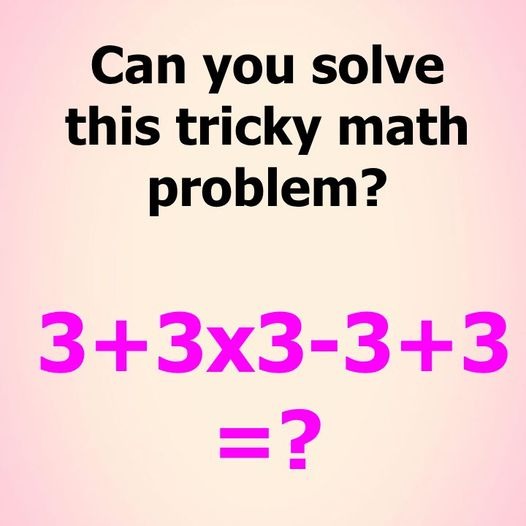
Math puzzles have a knack for capturing our attention, especially when they seem straightforward but end up being deceptively tricky. Recently, a particular math problem has been making the rounds on social media, challenging individuals to test their arithmetic skills and recall fundamental math principles. At first glance, it appears simple, but as many have discovered, it’s easy to get wrong if you’re not careful.
The Viral Math Problem
Let’s dive into the problem that’s been causing quite a stir:
3 + 3 × 3 – 3 + 3
Seems simple, right? However, the variety of answers people provide indicates a common misunderstanding of basic mathematical rules.
The Importance of the Order of Operations
To solve this problem correctly, it’s essential to follow the order of operations, a set of rules that dictates the sequence in which mathematical operations should be performed. Neglecting these rules can lead to incorrect results.
PEMDAS: Your Guide to Solving Equations
You might recall the acronym PEMDAS from your school days, which stands for:
- Parentheses
- Exponents
- Multiplication
- Division
- Addition
- Subtraction
This acronym helps remember the hierarchy of operations. It’s crucial to perform multiplication and division before addition and subtraction, working from left to right.
Applying PEMDAS to the Problem
Let’s break down the problem step by step:
-
Identify and Perform Multiplication First
In the equation 3 + 3 × 3 – 3 + 3, locate the multiplication operation:
3 × 3 = 9
-
Rewrite the Equation
Substitute the result of the multiplication back into the equation:
3 + 9 – 3 + 3
-
Perform Addition and Subtraction from Left to Right
Now, proceed with the remaining operations:
- 3 + 9 = 12
- 12 – 3 = 9
- 9 + 3 = 12
Thus, the correct answer is 12.
Common Pitfalls and Misconceptions
Many individuals make the mistake of performing operations from left to right without considering the order of operations. For instance, adding 3 + 3 first to get 6, then multiplying by 3 to get 18, leads to an incorrect result. This oversight underscores the importance of adhering to PEMDAS.
Why Are Such Puzzles So Engaging?
Math puzzles like this captivate us because they challenge our understanding and recall of basic principles. They serve as a reminder of the foundational rules we might have forgotten and offer a fun way to test our cognitive skills.
The Cognitive Benefits of Solving Math Puzzles
Engaging in these puzzles isn’t just entertaining; it also offers cognitive benefits:
- Enhances Problem-Solving Skills: Tackling such problems encourages analytical thinking.
- Improves Memory: Recalling mathematical rules and applying them strengthens memory retention.
- Boosts Concentration: Focusing on solving puzzles enhances attention to detail.
Tips to Approach Similar Math Problems
- Stay Calm: Don’t rush; take your time to understand the problem.
- Recall PEMDAS: Always keep the order of operations in mind.
- Double-Check Your Work: Review each step to ensure accuracy.
Challenge Your Friends and Family
Why not share this puzzle with others? It’s a great way to engage in friendly debates and see who remembers their math rules.
Conclusion
Math puzzles, especially those that seem simple but are deceptively tricky, offer a delightful challenge. They remind us of the importance of foundational principles like the order of operations. So, the next time you come across such a problem, remember PEMDAS, take your time, and enjoy the process of finding the solution.





